For off-grid living, you'll find several portable air heater designs that offer efficient warmth without relying on the grid. Top options include the DIY Pop-Can Solar Air Heater, Window-Mounted Solar Heating Panels, and Recycled Aluminum Radiator Designs. For lightweight solutions, consider Inflatable Solar Air Heaters or Parabolic Trough Collector Systems. Flat-Plate Collector Heaters and Thermosiphon Solar Air Heaters provide simple yet effective heating. Transpired Solar Collectors and Trombe Wall Heating Systems offer larger-scale solutions for fixed off-grid homes. Each design has unique features to suit various needs and environments. Explore these options to discover which portable heater will best keep you cozy in your off-grid adventure.
Pop-Can Solar Air Heater
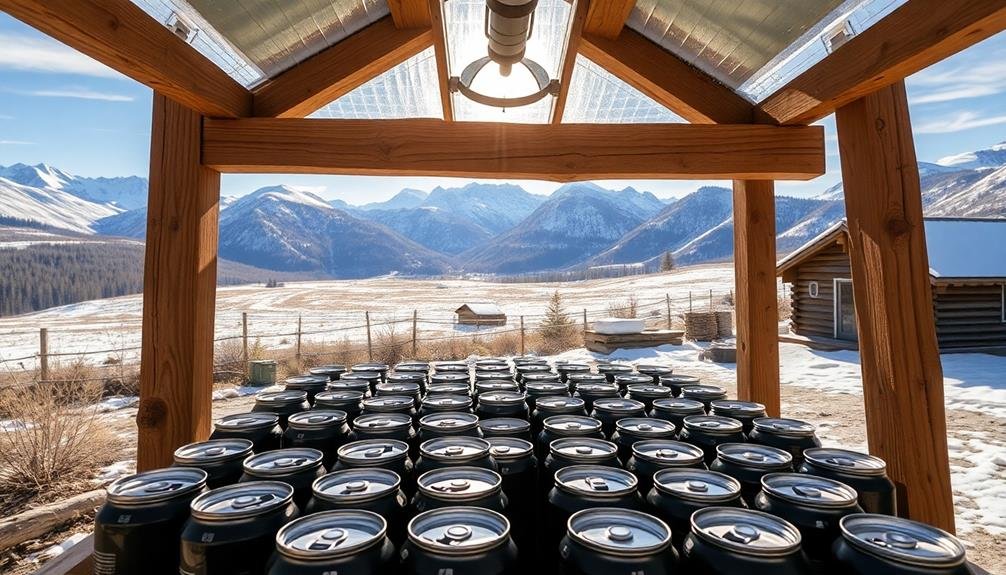
The Pop-Can Solar Air Heater is a DIY enthusiast's dream come true. This innovative design harnesses the sun's energy to heat your off-grid living space efficiently and cost-effectively. You'll need aluminum cans, a wooden frame, plexiglass, and basic tools to construct this eco-friendly heater.
Start by cutting the tops off the cans and drilling holes in their bottoms. Stack them vertically in columns within your wooden frame, creating air channels. Paint the cans black to maximize heat absorption. Cover the front with plexiglass to trap heat, and add intake and output vents.
As sunlight hits the plexiglass, it warms the air inside the cans. Hot air rises through the channels and exits through the top vent, drawing cooler air in from the bottom. This creates a natural convection current that circulates warm air into your living space.
You can mount this heater on a south-facing wall or create a portable version on wheels. It's silent, requires no electricity, and can greatly reduce your heating costs.
With proper insulation and sizing, a Pop-Can Solar Air Heater can provide substantial warmth for your off-grid home during daylight hours.
Window-Mounted Solar Heating Panel
Window-mounted solar heating panels offer an energy-efficient passive heating solution for your off-grid home.
You'll find these panels easy to install yourself, requiring minimal tools and expertise.
They can provide valuable supplemental warmth, especially during sunny winter days, reducing your reliance on other heating methods.
Energy-Efficient Passive Heating
Efficiency meets simplicity with window-mounted solar heating panels, offering a passive yet powerful way to warm your off-grid space. These panels harness the sun's energy without any moving parts or electricity, making them ideal for sustainable living.
You'll find these panels easy to install on south-facing windows. They consist of a dark-colored absorber plate behind a glass or plastic cover. As sunlight passes through the transparent layer, it heats the absorber plate. The trapped heat then radiates into your living space, raising the indoor temperature.
For maximum effectiveness, you'll want to guarantee proper sizing and placement. Consider factors like your local climate, window size, and heating needs. Some models come with reflective backing to minimize heat loss and improve efficiency.
You can enhance the performance of your solar heating panels by using insulating curtains at night to retain heat. During summer, you may need to cover or remove the panels to prevent overheating.
While these systems work best in sunny climates, they can still provide supplemental heating in less ideal conditions, reducing your reliance on other heating methods.
Easy DIY Installation
Installing your own window-mounted solar heating panel is a straightforward process that can save you money and provide valuable hands-on experience. You'll need basic tools like a drill, screwdriver, and measuring tape.
Start by choosing a south-facing window that receives ample sunlight throughout the day. Measure your window and purchase a solar panel kit that fits. These kits typically include the panel, frame, and mounting hardware.
Clean the window thoroughly before beginning installation. Attach the mounting brackets to your window frame, making sure they're level and secure. Carefully place the solar panel into the brackets, making sure it's snug and doesn't wobble.
Next, connect the panel to your home's heating system. This usually involves running insulated tubing from the panel to your existing ductwork or radiant floor system. You'll need to drill small holes for the tubing, so be precise in your measurements.
Install a thermostat to control the system, and don't forget to add a heat transfer fluid to the panel for peak performance.
Always follow the manufacturer's instructions and local building codes. If you're unsure about any step, consult a professional to guarantee safe and effective installation.
Supplemental Off-Grid Warmth
A reliable source of supplemental warmth is crucial for off-grid living, and window-mounted solar heating panels offer an excellent solution. These panels harness the sun's energy to heat your space, reducing your reliance on other heating methods. You'll appreciate their simplicity and effectiveness, especially during sunny winter days.
To maximize the benefits of window-mounted solar heating panels, consider these key factors:
| Feature | Benefit | Consideration |
|---|---|---|
| Size | Increased heat output | Available window space |
| Orientation | Ideal sun exposure | South-facing windows |
| Insulation | Heat retention | Double-pane compatibility |
| Ventilation | Air circulation | Adjustable vents |
| Material | Durability | Weather resistance |
When choosing a solar heating panel, look for models with adjustable vents to control airflow and heat distribution. You'll want to confirm proper installation to prevent drafts and maximize efficiency. Remember, these panels work best as a supplemental heat source, so combine them with other off-grid heating methods for a thorough warming strategy. By incorporating window-mounted solar heating panels into your off-grid setup, you'll enjoy a sustainable and cost-effective way to stay warm during colder months.
Recycled Aluminum Radiator Design
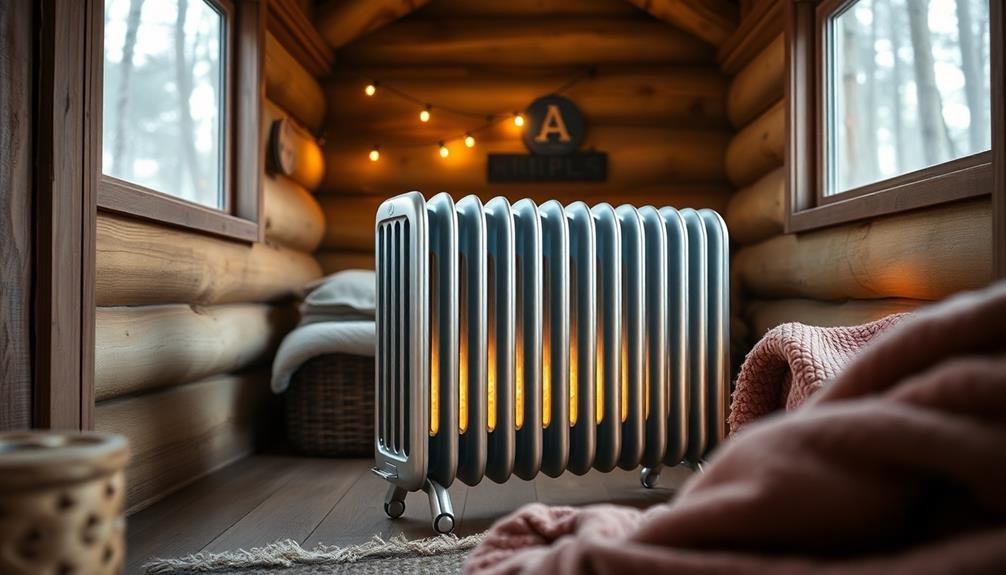
You'll find that recycled aluminum radiator designs offer remarkable efficiency in heat distribution.
These innovative heaters utilize repurposed materials to create lightweight, compact units that are perfect for off-grid living.
With their ability to quickly warm up spaces and maintain consistent temperatures, you're getting a sustainable heating solution that doesn't compromise on performance.
Efficient Heat Distribution
How does a portable heater efficiently distribute warmth throughout your off-grid living space? The key lies in its design and features.
Look for heaters with built-in fans or blowers that circulate warm air quickly and evenly. These fans push heated air outward, creating convection currents that help distribute warmth more effectively throughout your space.
Consider models with oscillating functions, which rotate back and forth to spread heat in multiple directions. This feature is particularly useful in larger areas or oddly shaped rooms.
Some advanced portable heaters come with smart sensors that detect cold spots and adjust their airflow accordingly, ensuring uniform heat distribution.
Pay attention to the heater's heat output and coverage area. A higher BTU rating generally means more heating power, but it's crucial to match this to your space size for maximum efficiency.
Radiant heaters can be excellent for direct, focused warmth, while ceramic heaters often provide more even, room-filling heat.
Lastly, don't overlook the importance of proper placement. Position your heater in central locations, away from obstacles, to maximize air circulation and heat distribution throughout your off-grid living area.
Lightweight Compact Construction
For off-grid living, lightweight and compact heaters are essential, and recycled aluminum radiator designs offer an excellent solution.
These innovative heaters utilize recycled aluminum to create efficient, portable heating units that won't weigh you down during your off-grid adventures.
You'll appreciate the sleek, space-saving design of these heaters, which can easily fit into tight spaces in your off-grid setup. The use of recycled aluminum not only reduces the environmental impact but also provides excellent heat conductivity, ensuring quick and effective warming of your living space.
These heaters typically feature a modular construction, allowing for easy assembly and disassembly. This makes them ideal for transport and storage when not in use.
You'll find that many models come with carrying handles or wheels, further enhancing their portability.
The durability of recycled aluminum means your heater will withstand the rigors of off-grid living, resisting corrosion and maintaining its efficiency over time.
Some designs even incorporate foldable elements, allowing you to compact the heater even further when packing up camp or moving to a new location.
Inflatable Solar Air Heater
Innovation meets sustainability in the inflatable solar air heater, a groundbreaking solution for off-grid heating needs. You'll find this unique design combines portability with eco-friendly technology, making it an ideal choice for remote locations.
The inflatable structure allows for easy transport and setup. When deflated, it takes up minimal space in your gear. Once inflated, it creates a large surface area to capture solar energy efficiently. The transparent outer layer traps heat, while the dark inner surface absorbs sunlight and converts it to warmth.
Here's a breakdown of the inflatable solar air heater's key features:
| Feature | Benefit |
|---|---|
| Lightweight | Easy to carry |
| Inflatable | Compact storage |
| Solar-powered | No fuel needed |
| Large surface area | Efficient heat capture |
| Durable materials | Long-lasting use |
You'll appreciate the heater's versatility in various off-grid scenarios. It's perfect for warming tents, cabins, or small spaces without relying on traditional energy sources. The design's simplicity means there are fewer parts to maintain or replace, ensuring reliability in remote locations. By harnessing the sun's energy, you're not only staying warm but also reducing your environmental impact.
Parabolic Trough Collector System

You'll find the parabolic trough collector system to be a highly efficient solar heat capture method for your off-grid living needs.
This compact heating solution uses curved mirrors to concentrate sunlight onto a receiver tube, which then heats the air or fluid inside.
Efficient Solar Heat Capture
When it comes to efficient solar heat capture for off-grid living, parabolic trough collector systems stand out as a powerful solution. These systems use curved mirrors to concentrate sunlight onto a receiver tube filled with a heat-transfer fluid. As you explore this technology, you'll find it's a game-changer for generating heat and even electricity in remote locations.
The parabolic trough's design allows for maximum solar energy absorption throughout the day. You'll appreciate its ability to track the sun's movement, ensuring peak heat capture from dawn to dusk. This system can heat fluids to temperatures exceeding 750°F, making it ideal for various applications, including space heating and hot water production.
| Feature | Benefit | Emotion |
|---|---|---|
| High efficiency | More heat from less space | Satisfaction |
| Modular design | Easy expansion | Flexibility |
| Low maintenance | Worry-free operation | Peace of mind |
| Dual-use potential | Heat and electricity generation | Empowerment |
| Sustainable energy | Reduced carbon footprint | Pride |
Compact Off-Grid Heating Solution
Parabolic trough collector systems have revolutionized off-grid heating, and their compact versions are making waves in portable solutions. These systems use curved mirrors to concentrate sunlight onto a tube filled with a heat-transfer fluid, which then powers a small generator or directly heats your living space.
You'll find that these portable versions are lightweight, easy to set up, and highly efficient, making them ideal for off-grid living or emergency situations.
When considering a compact parabolic trough system, you'll appreciate these emotional benefits:
- Freedom: Break free from reliance on traditional power grids
- Self-sufficiency: Generate your own heat, even in remote locations
- Environmental stewardship: Harness clean, renewable solar energy
- Peace of mind: guarantee warmth and comfort in any situation
The system's modular design allows you to scale up or down based on your heating needs. You can easily transport and assemble it, making it perfect for temporary shelters or mobile homes.
With proper maintenance, these systems can last for years, providing a reliable and sustainable heating solution for your off-grid lifestyle.
Evacuated Tube Solar Heater
Why settle for traditional heating methods when you can harness the power of the sun? Evacuated tube solar heaters offer an efficient, eco-friendly solution for off-grid living. These innovative devices use vacuum-sealed glass tubes to capture and retain solar energy, converting it into heat for your living space.
The evacuated tube design minimizes heat loss, making it effective even in colder climates. You'll appreciate its versatility, as it can be used for both space heating and water heating. Installation is straightforward, and once set up, you'll enjoy low maintenance costs and zero fuel expenses.
Here's a comparison of evacuated tube solar heaters with other heating options:
| Feature | Evacuated Tube | Electric Heater | Propane Heater | Wood Stove |
|---|---|---|---|---|
| Fuel Source | Sun | Electricity | Propane | Wood |
| Operating Cost | Very Low | High | Medium | Low |
| Environmental Impact | Minimal | High | Medium | Medium |
| Maintenance | Low | Low | Medium | High |
Flat-Plate Collector Heater
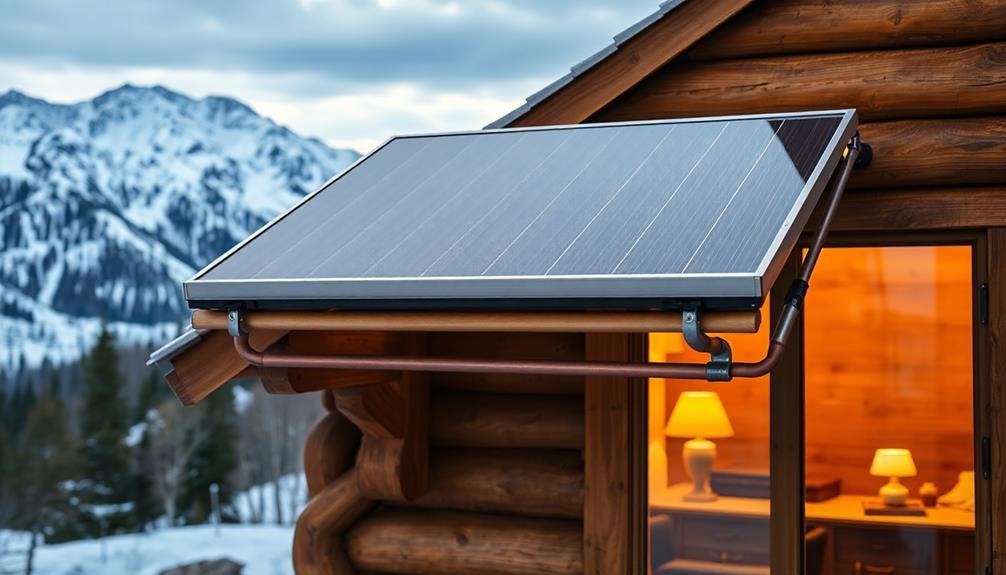
Another popular solar heating option for off-grid living is the flat-plate collector heater. This system uses a large, flat surface to absorb solar energy and transfer it to a fluid, typically water or air. The heated fluid is then circulated through your living space, providing warmth and comfort.
Flat-plate collectors are known for their simplicity and durability. They're often less expensive than evacuated tube systems and can be easier to maintain. You'll find that these heaters work well in a variety of climates, though they're most efficient in areas with consistent sunlight.
When considering a flat-plate collector heater for your off-grid setup, keep these emotional benefits in mind:
- Freedom from reliance on fossil fuels
- Pride in using renewable energy
- Peace of mind during power outages
- Satisfaction of reducing your carbon footprint
To maximize the efficiency of your flat-plate collector, you'll want to guarantee proper installation and orientation. South-facing installations typically work best in the Northern Hemisphere.
You can also integrate these systems with thermal storage solutions, allowing you to store heat for use during cloudy days or at night.
Thermosiphon Solar Air Heater
For those seeking a low-cost, passive solar heating solution, the thermosiphon solar air heater is an excellent choice. This system relies on natural convection to circulate air without the need for pumps or fans, making it ideal for off-grid living.
You'll find that thermosiphon heaters typically consist of a flat, dark-colored absorber plate enclosed in an insulated box with a transparent cover. As sunlight passes through the cover, it heats the absorber plate, which in turn warms the air inside the box. The heated air rises naturally, creating a circulation loop that draws cooler air from your living space into the bottom of the heater.
To install a thermosiphon heater, you'll need to position it on a south-facing wall or roof, with intake and output vents connecting to your living area. The system's efficiency depends on proper sizing and placement to maximize solar exposure and minimize heat loss.
While thermosiphon heaters work best in sunny climates, they can still provide supplemental heating in less ideal conditions.
You'll appreciate their silent operation, low maintenance requirements, and ability to function without electricity, making them a reliable and sustainable heating option for your off-grid home.
Transpired Solar Collector Design
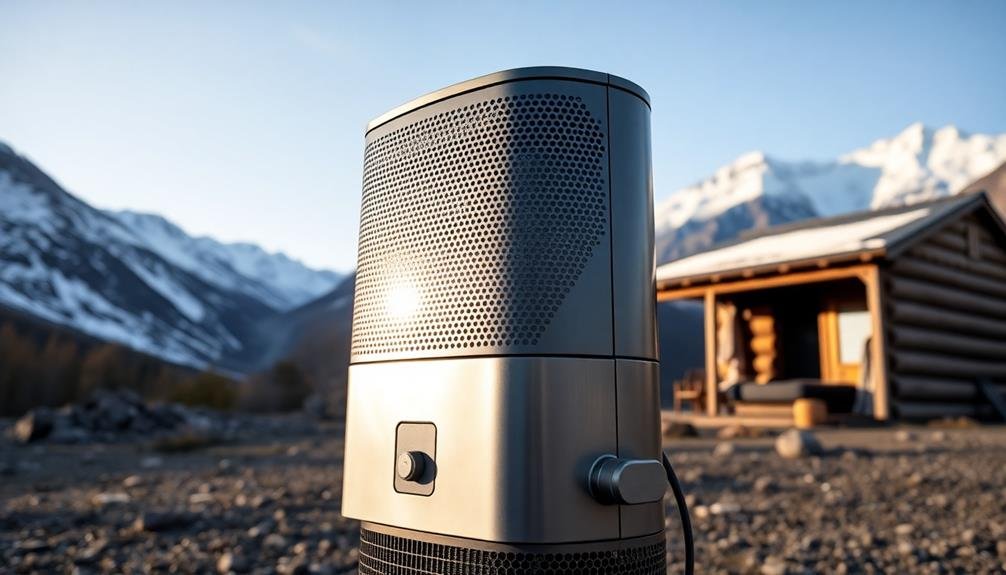
While thermosiphon heaters offer a passive solar solution, transpired solar collectors take a more active approach to harvesting solar energy for heating.
These systems use a perforated dark-colored metal panel mounted on a south-facing wall with a small gap between the panel and the wall. As sunlight heats the metal, a fan draws air through the tiny holes, heating it before distributing it into your living space.
You'll find transpired solar collectors particularly effective for off-grid living due to their simplicity and efficiency. They can heat large volumes of air quickly, making them ideal for workshops, greenhouses, or open-plan living areas.
The design's versatility allows you to integrate it into existing structures or incorporate it into new builds.
When considering a transpired solar collector, you'll experience:
- Improved air quality as the system filters incoming air
- Lower energy costs compared to traditional heating methods
- Reduced carbon footprint through renewable energy use
- Enhanced comfort with evenly distributed warm air
Trombe Wall Heating System
Harness the power of passive solar heating with a Trombe wall system. This innovative design uses a thick, dark-colored wall facing south to absorb solar energy during the day and release it slowly at night.
You'll place a layer of glass or plastic a few inches in front of the wall, creating an air space that traps heat. As sunlight passes through the glazing, it's absorbed by the wall's dark surface. The wall heats up, and the trapped air between the wall and glazing rises.
You can install vents at the top and bottom of the wall to circulate this warm air into your living space. At night, when temperatures drop, the stored heat in the wall radiates into your home.
To maximize efficiency, use materials with high thermal mass like concrete, stone, or adobe for the wall. You can also add insulating shutters or curtains to prevent heat loss at night.
While not portable, a Trombe wall is an excellent option for off-grid homes with a fixed location, providing free, sustainable heating throughout the cold months.
Frequently Asked Questions
How Do Portable Air Heaters Compare to Traditional Heating Systems in Energy Efficiency?
You'll find portable air heaters are generally less energy-efficient than traditional heating systems. They're designed for spot heating, so they use more energy to warm smaller areas. However, they're convenient for targeted, on-demand heat when needed.
Can These Heaters Be Used in Extreme Cold Climates Effectively?
You can use portable air heaters in extreme cold climates, but they're not as effective as larger systems. They'll warm small spaces quickly, but you'll need multiple units or supplemental heating for larger areas or very low temperatures.
What Maintenance Is Required for Long-Term Use of Portable Air Heaters?
You'll need to regularly clean filters, check for fuel leaks, and inspect electrical components. Don't forget to lubricate moving parts, replace worn-out elements, and guarantee proper ventilation. It's essential to follow the manufacturer's maintenance schedule for peak performance.
Are There Any Safety Concerns Specific to Off-Grid Portable Air Heaters?
You should be aware of carbon monoxide risks, fire hazards, and proper ventilation. Don't use them in enclosed spaces, keep flammable items away, and guarantee fuel sources are secure. Regular maintenance and following manufacturer guidelines are essential for safety.
How Do Portable Air Heaters Impact Indoor Air Quality in Small Spaces?
You'll notice portable air heaters can affect indoor air quality in small spaces. They may reduce humidity, increase dust circulation, and emit odors. Some models can produce pollutants like carbon monoxide, so proper ventilation is essential for your safety.
In Summary
You've now explored a variety of innovative portable air heater designs perfect for off-grid living. From simple pop-can heaters to advanced parabolic trough systems, there's a solution for every need and skill level. Remember, these eco-friendly options can greatly reduce your energy costs and environmental impact. Whether you're living off-grid full-time or just preparing for emergencies, consider incorporating one of these sustainable heating solutions into your setup. Stay warm and self-sufficient!


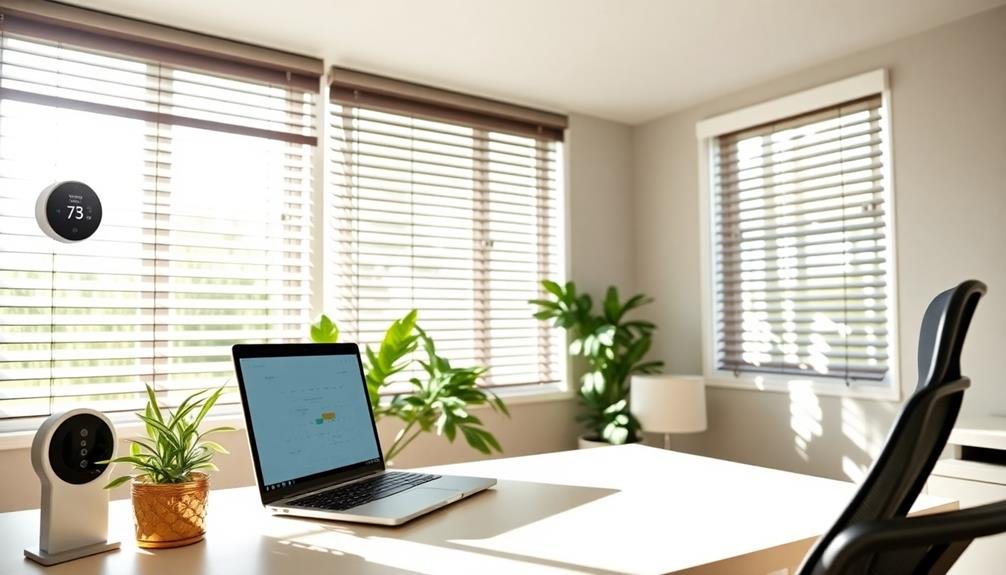
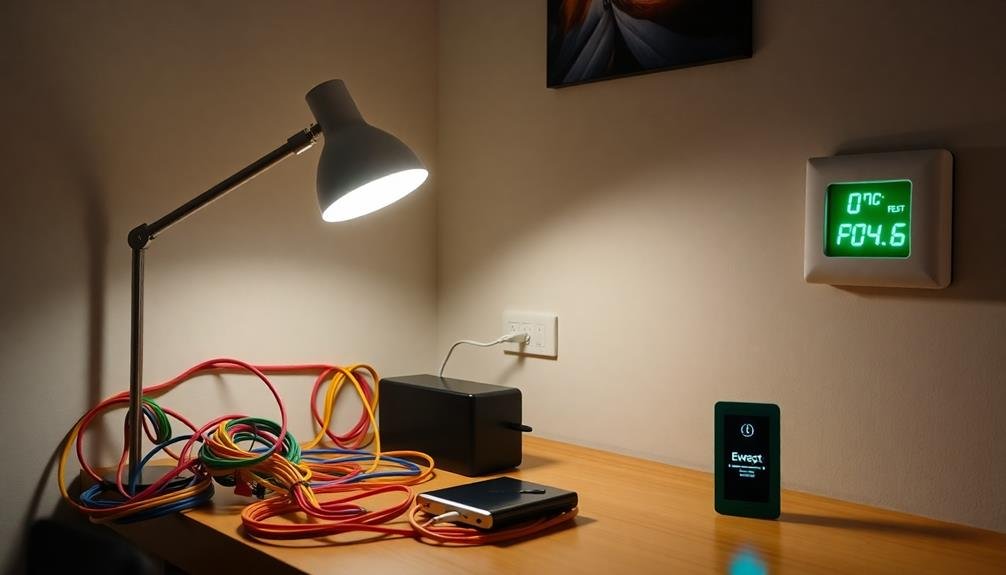
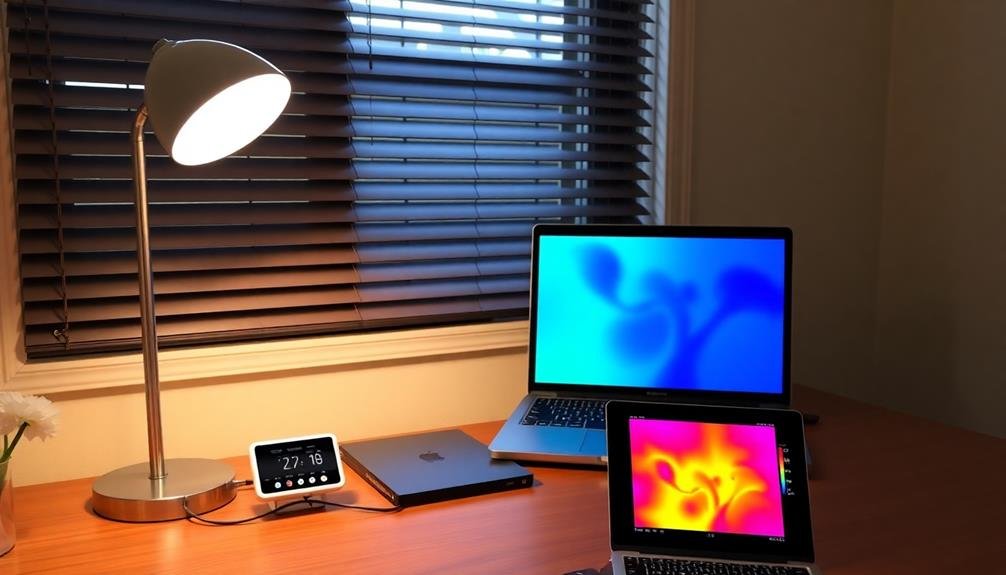
Leave a Reply